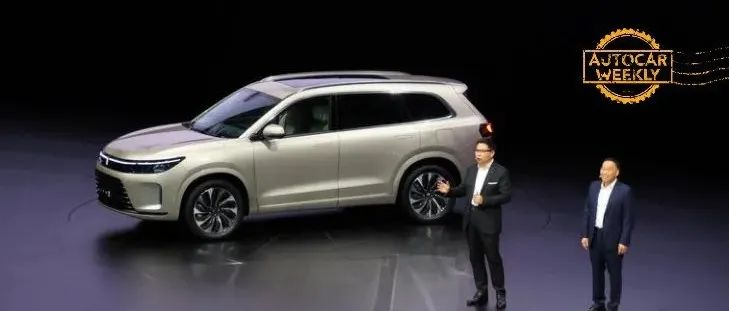Woof Woof Hu
Over a month ago, also in Shenzhen, Yu Chengdong boasted at the Guangdong-Hong Kong-Macau Auto Show that the upcoming Honor Joint-M7 would “beyond million-dollar luxury cars,” which made He XPeng who followed him on stage joke, “I’m really looking forward to how you would describe the third car (next generation) when it’s released.” (Would it be “a two million luxury car”?) He XPeng may have to wait a bit longer, as everyone needs to take a closer look at the second car of the Honor brand, the M7. If Yu Chengdong knew then, that the slogan “the best under 5 million” would become so popular, he might have reconsidered stating “beyond million” as their official slogan.
The “million-dollar luxury car” placed in Huawei Stores has a final price of 3.198-3.798 million yuan.
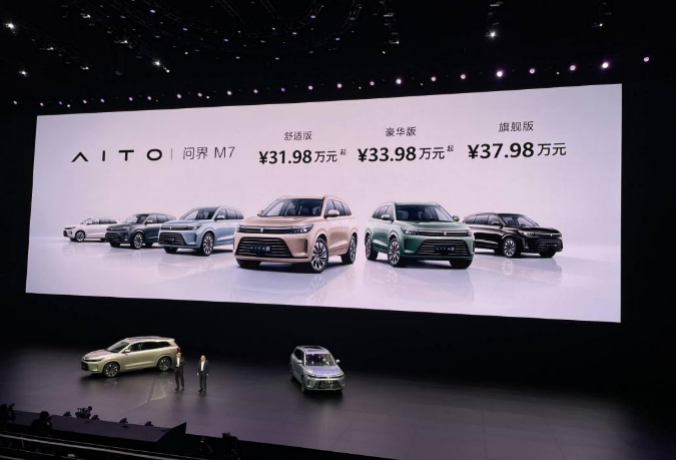
Bigger than bigger
Cook couldn’t have imagined that “bigger than big” would make a comeback someday.
Anyone who knows their numbers knows that the M7 is bound to be one size bigger than the Honor Joint-M5. Specifically speaking, the M7 is one and a half times bigger than the midsize SUV (M5), with a length exceeding the five-meter mark at 5020mm, which is the same size as the Ideal ONE and Nio ES8.
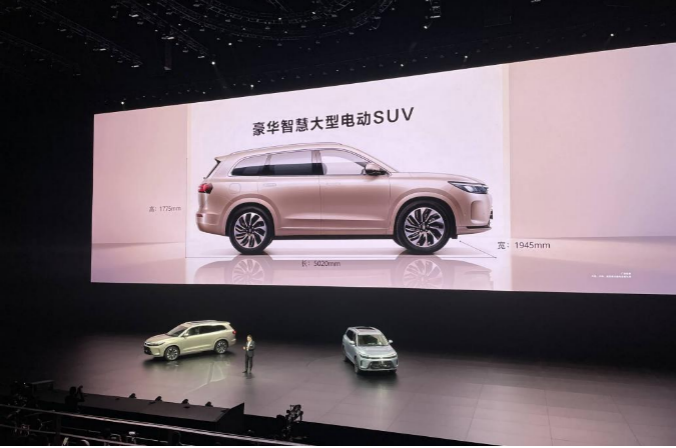
However, what’s worth noting is that Honor Joint-M7 does not emphasize its wheelbase. According to data, it is relatively shorter at 2820mm compared to the shorter length of the car. In contrast, the M5’s wheelbase is 2880mm, slightly longer. The Ideal ONE, which is the same size as the M7, has a wheelbase of 2935mm, while the Nio ES8 has the longest wheelbase at 3010mm among the three (it doesn’t have to worry about an internal combustion engine since it’s an all-electric platform). Although the M7’s wheelbase is not prominent, Yu Chengdong still emphasizes the “real big six-seater space.”
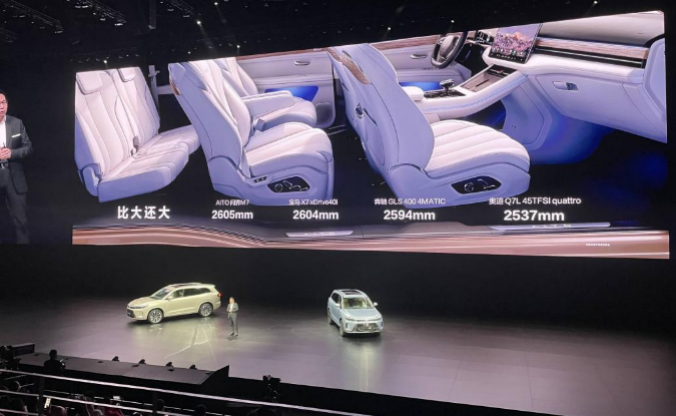
According to Yu Chengdong’s classic comparison method, as a three-row SUV, the Honor Joint-M7 has achieved the largest passenger cabin space of 2605mm among its peers on the x-axis (lengthwise), surpassing the million-dollar three-row SUVs of the three BBA brands, even if the difference between the former two is only measured in millimeters. Despite being at a disadvantage with its wheelbase, the M7’s cabin space surpasses its rivals, but is it some kind of strange Doctor Strange magic? Yu Chengdong also provided an explanation, along with a little science lesson about the L113 term.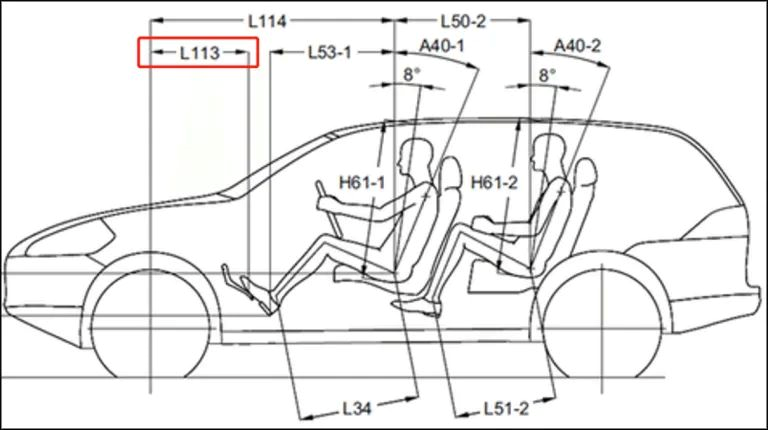
L113 is an important parameter in the definition of overall vehicle dimensions, which refers to the distance from the front axle center to the driver’s feet in the front row. The so-called dash-to-axle, the distance from the A-pillar to the wheel center, mentioned in some car design articles, is often similar to L113.
AITO claimed that their self-developed 6-in-1 turbocharger powertrain shortened the length of L113 (which can be understood as moving the powertrain as far forward as possible), thereby reducing the “shared space” and improving the vehicle’s space utilization.
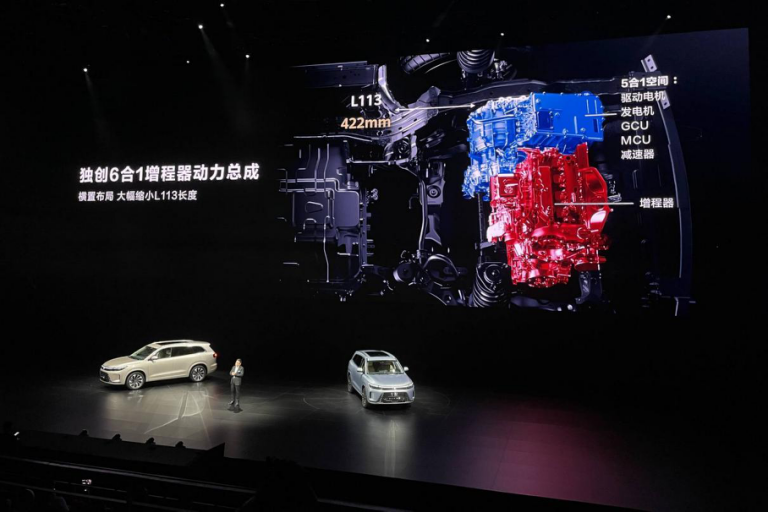
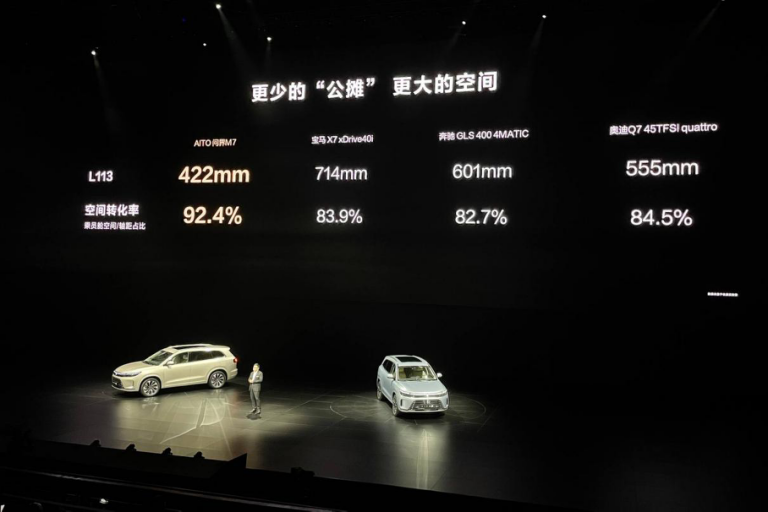
It may sound confusing, so let’s explain it with the help of the previous picture: by shortening the red length, the ratio of the green length to the blue length is maximized.
However, this calculation method of “space/axle distance” completely ignores the difference in the lengths of the front overhangs between longitudinally and transversely mounted models. When compared with longitudinally mounted models, the transversely mounted M7 may be accused of taking shortcuts.
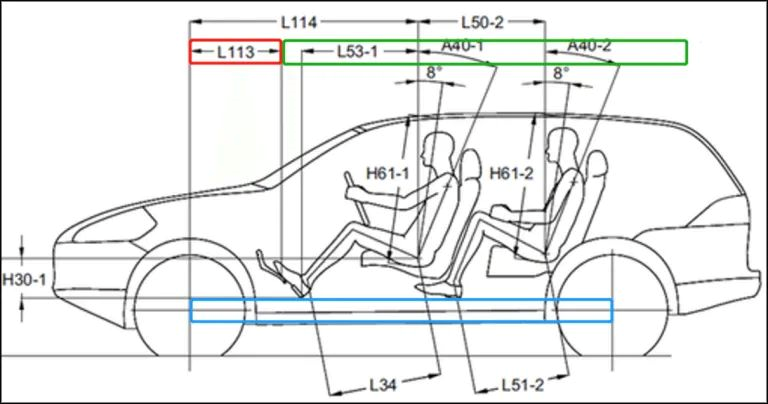
However, disregarding the percentage of numerology games, the large space of a three-row seat is measurable. Space is only a foundation. When describing “beyond one million,” Yu Chengdong specifically mentioned the names of MPVs such as Alphard and Lexus LM. The killer feature that M7 uses to make use of the large space is the AITO zero-gravity seat in the second row, which can kick like the luxurious aviation seats in MPVs.

Unlike the common rear boss seats in luxury sedans and MPVs, the AITO-zero-gravity seat can be reclined to an exaggerated angle, with the seat cushion tilted backward and raised to 30°. To achieve this degree of recline, the second-row seats need to be moved inward at the same time to avoid the rear wheel arch protrusion behind the normal position of the rear seats.
For this reason, AITO has developed a three-axis six-electric motor drive system to achieve up to 113° of flat angle while achieving y-axis translation during reclining actions. Its concept is to reduce the pressure of whole-body blood circulation by raising the knees to the same level as the heart through a large recline angle, achieving the so-called “zero gravity” concept.## “Greatest Harmony” Upgraded Again
As a Huawei Inside intelligent car, intelligence is an indispensable feature. The new Hongmeng car system brought by M7 adds a new feature called “Super Desktop”, which can project Huawei phone apps onto the car screen.
In theory, it can be understood as phone screen projection, but compared to simple screen projection, Super Desktop is more like what Huawei has done on laptops and tablets, using the car’s large screen to expand phone operations. For example, the car screen can display four pages of apps at once, and can use landscape screen display to achieve split-screen operation similar to the “Parallel Window” function on tablets.
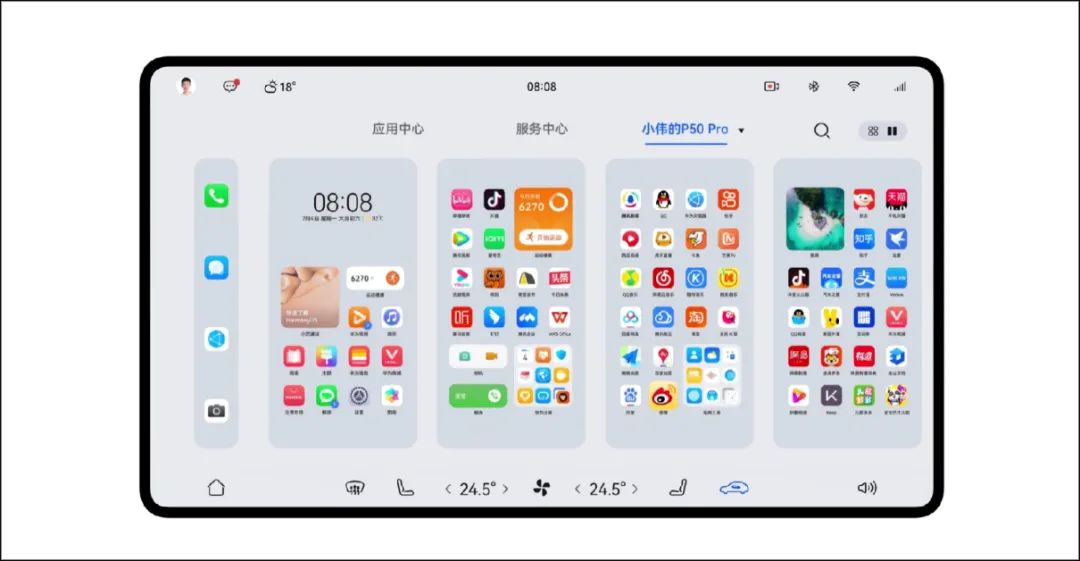
In fact, in terms of interconnection and resource sharing between laptops, tablets, and phones, Huawei’s ecosystem has always been the best, even surpassing Apple’s ecosystem in many ways. However, for many automakers who are envious of CarPlay, operating phone apps on the car’s interface can be a difficult obstacle to overcome, even more difficult than many cutting-edge technologies.
In terms of intelligent driving, the automatic parking function of M7 has added a customized parking space feature, allowing users to choose a parking area in places without parking lines. The built-in car-finding mode can automatically recognize the parking floor and display it on the notification page of the bound phone, avoiding the embarrassment of searching for a car on floors B1-B3.
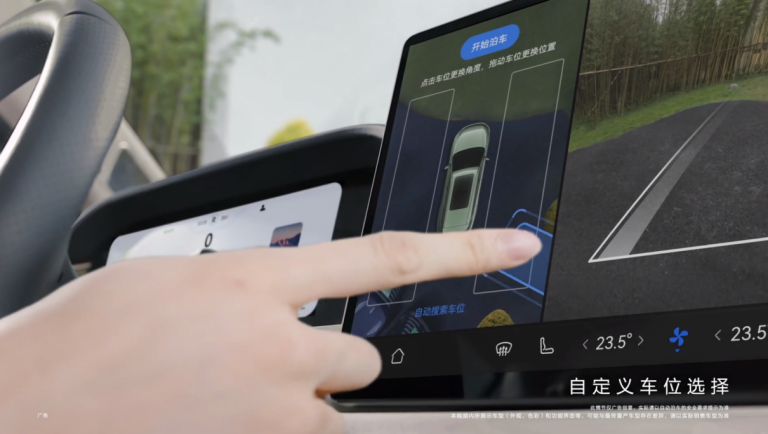
Of course, these software upgrades can also be enjoyed by the M5 model.
The greater changes brought by M7 are mainly in the size and positioning aspects. It has two versions: rear-wheel drive and four-wheel drive, with a pure electric endurance mileage of 200~230km and acceleration time from 0 to 100km/h of 7.8s and 4.8s, respectively. The 1.5T four-cylinder engine with a Miller cycle has a compression ratio of 15:1 and uses EGR exhaust gas recirculation technology to improve energy efficiency. The official thermal efficiency is up to 41%.

However, Yu Chengdong again revealed a secret to electric car manufacturers, confessing that it is not difficult for electric cars to improve their power and “reach 0 to 100km/h acceleration in 4 or 3 seconds”. The implication is that improving M7’s acceleration is easy, but it is not necessary due to its positioning, not because it is unable to do so.So, for a family SUV, balanced energy consumption is more important, and the CLTC fuel consumption given by M7 is as low as 5.8L/6.3L (rear-wheel drive / four-wheel drive). Meanwhile, Yu Chengdong also generously stated that the CLTC standard is too low, so we will directly give the 6.85L/7.5L per 100 kilometers under the WLTC standard.
This number stands out among the competitors of BBA’s cars, only comparable to the ideal L9, which is not competitive. Yu Chengdong often talks about his commuting story in the Pearl River Delta, driving a range-extended car, and is very confident in the actual fuel consumption of the WENJIE, “the actual fuel consumption is only half of that of the same level fuel cars.”
Overall, compared with the already-launched WENJIE M5, M7 has not exceeded the upgrade range of the older sibling except for the unprecedented zero-gravity rear seat. Most of M7’s upgrades are natural results of size and positioning improvement, and the upgrade of intelligence can be enjoyed in M5 OTA as well.
However, some changes are not easy to be reflected in the parameter configuration table. The zero-gravity seat has various patents and certifications, but what is more noteworthy is that under Huawei’s intervention, WENJIE dared to do this unusual configuration that other car manufacturers could obviously accomplish but dare not attempt. That is, design and use such a configuration on a family SUV with an unremarkable price.
The same concept is also reflected in other configurations inside the car, such as the front two rows of heating + ventilation + massage that are standard across the line, the large soft makeup mirror that is twice the size of many other models, and the front row charging that uses dual 40W wireless fast charging (even with air-cooling) and dual 66W wired fast charging.
Are these really high-tech? Obviously, they are not, but except for Huawei and WENJIE, there seem to be few manufacturers willing to let a car have the courage and power to have the latest standards in this type of detailed experience. Don’t you see that even a charging port still has many car manufacturers using the ancestral USB2.0, fiddling around.
The rise of new car manufacturing has brought a lot of controversy, but there are also some changes that are undoubtedly good for consumers. People often understand this detail fan as “folding,” but haven’t self-owned brands tried the road of stacking configurations in the past? Stacking materials is also a technology, and if the direction is wrong, resources will become junk.Except for the forward-looking and high-end intelligent future often discussed by everyone, Huawei, as an offline advantage digital consumer company, has a clearer grasp of consumer demand and preferences than traditional car companies separated by 4S stores.
What kind of “material” piled up can be given high selection weight by consumers, and is worth car companies spending energy to pile up, develop, and dig into a moat. This is also the value that Huawei brings to car companies, which is more realistic.
In the past, the independent brands always piled up configurations but only produced mediocre results. Today, though a bit far from million-dollar luxury cars, they have a taste that was absent before.
This article is a translation by ChatGPT of a Chinese report from 42HOW. If you have any questions about it, please email bd@42how.com.
